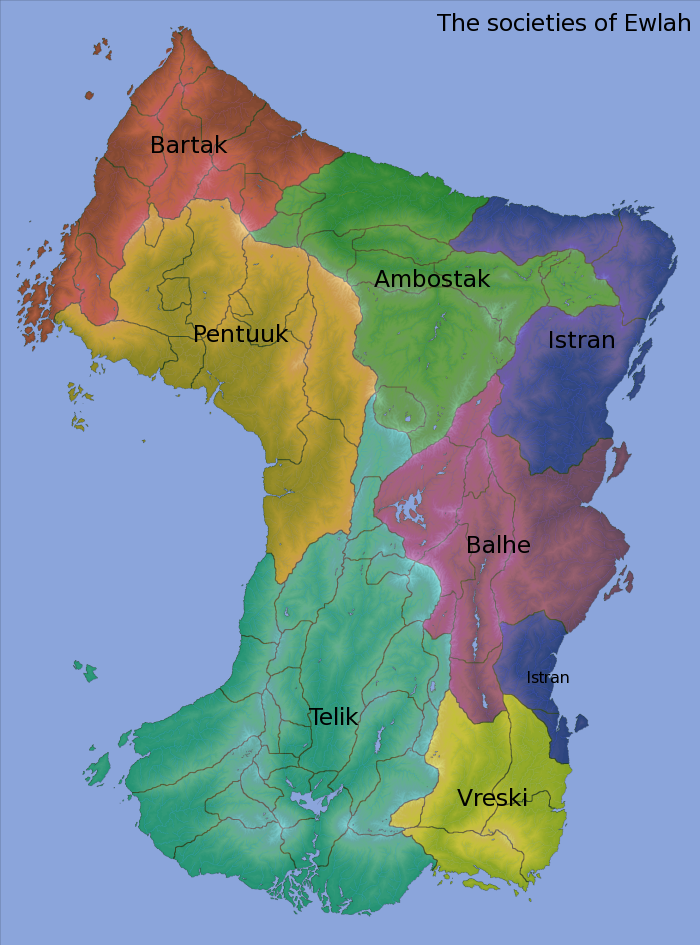The Lands of Ewlah
The political map of Ewlah is a complex map to draw, partly because of the complex webs of treaties and agreements between individual settlements, cities and Lands, but also because to date nobody has been able to come up with a succinct description of what a Land is. For this reason, the maps that are presented in this Encyclopaedia come with a health warning: what the maps show as a Land may not represent the true nature of the political and cultural realities on the ground.
Even the concept of a Society is open to debate. For instance, the people who form the Balhe Society are quite clear in their minds that there is such a thing as a Balhe Society; however people from other Societies - such as the Istran Society or the Vreski Society - will often deny that Balhe Society exists, but rather consider it to be a part of a much wider Vreski Society on the grounds that the Balhe peoples are entirely descended from Vreski stock.
Similarly, there is some debate about whether the Bartak, Pentuuk and Ambostak Societies are indeed Societies in their own right. In fact, the Bartak peoples would argue that they are the true descendants of the ancient (and possibly mythical) Bartak Empire that ruled the continent of Cheidrah some 3,000 orbits ago. The Ambostak people hold similar beliefs, though with themselves in the leading role and all other Societies being degenerate corruptions and copies. The Pentuuk Society takes a different stance again, arguing that everyone from Cheidrah is part of the same Society, and Bartak and Ambostak and Pentuuk are just different names for the same thing.
The map below shows the theoretical distribution of the Societies across the continent - although this, too, is not as accurate as some would like to believe as the map assigns some Lands to a particular Society where in fact two (or more) Societies have coexisted in that Land for hundreds of orbits, and the majority of people in the Land may well consider themselves to belong to neither of the parent Societies, but rather to a new Society of their own:

The above map - like most of the Ewlah maps in this Encyclopaedia - shows defined borders between each Land. Much of this is supposition as many Lands do not have agreed borders between them, and in some instances where there is an agreed border a settlement may have grown across the border since its agreement. Most of the borders that haven't been agreed between neighbouring Lands are shown in these maps as following watershed lines along mountain ridges, or alternatively river courses. Agreed borders have a tendency to be straignt lines originating from a specific point and extending east-west or north-south from that point.
Only a few Lands bother to guard or patrol their borders. Defensive positions tend to centre around cities, plantations and settlements, where they occur at all.
What is a Land?
Whatever a Land is, it didn't exist prior to the colonisation of Ewlah. Historically, the continent of Cheidrah was divided into discrete regions (also known as provinces) which only in the last two hundred orbits before the Disaster began to take on the trappings of nationhood. The continent of Falah, by contrast, had known both Nation States (such as the Telik Nations) and Imperial government (for example, the Vreski Empire) for thousands of orbits. In both continents, there existed a tradition of centralisation, with the needs of the settlement subservient to the needs of the larger political entity.
The intellectual concept of the Land as a political formation of settlements bound together by agreements of mutual self-help first arose in the Nakap communities of the Telik Society, and this bottom-up approach to political governance has proved to be the most influential across the continent. One pertinent reason for this has been the sheer size of the continent, and the difficulties involved in travelling between settlements and cities. For all Societies, the self-reliance of the settlement was a key factor in the successful spread of the Society across the continent. The history of the Vreski Empire illustrates this well: prior to the Disaster the growth of the centrally controlled Imperial provinces had been slow; the expansion of the Balhe Society following the collapse of the Empire, based squarely on the self-sufficiency of the settlements and mutual co-operation between them, was much more rapid. A similar pattern of events can be seen in both the Ambostak and Pentuuk Societies, though with less death and destruction involved.
So the key definition of a Land is that the people and settlements within the Land actually agree there is a Land-bond between them. This has led to the establishment of over 80 separate political entities calling themselves Lands (though a few areas do not even call themselves Lands). Over time, these entities have taken on distinctive - and different - cultural and political lives. Some Lands today can be thought of as fully fledged Nation States with all the accompanying paraphinalia such as a centrally controlled currency and national institutions; other Lands remain a collective of their constituent settlements and cities, with most political power wielded at the local level. A few Lands consist of just one settlement or city. One Land - Pesane - is an artificial construct, an experiment in inter-Societal scientific co-operation.
The purpose of this section of the Encyclopaedia is to introduce each of these Lands, providing a physical, historical and cultural description of each. Information on each of the Ewlah Societies can be found elsewhere on this website.